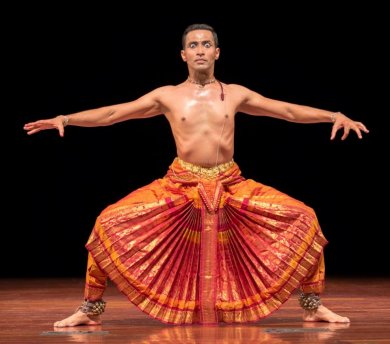
|   |

|   |
Bharata by Ganesh Vasudeva - Priya Das e-mail: priyafeatures@gmail.com April 15, 2015 Ganesh Vasudeva presented his Bharata - The Quintessential Male Dancer, at the Counter Pulse Theater in San Francisco on April 11, 2015. The space provided a heightened art experience, with its all-black interior, elevated seating for the audience, and acoustics-for-the-arts.  Ganesh connected with the audience right away, apologizing for taking us away from a beautiful day but promising to make up for it through his presentation. The first piece was Gangavatarana, Descent of the Ganges, in Poorvi Kalyani based on Gangadhara by Mysore Sadashiva Rao. The introduction was unusual, since contrary to the hero theme, Ganesh chose to unveil the heroine’s - Ganga’s - perspective. He has presented this piece before, but it remains fresh as there are three characters, lots of drama, and several emotional layers. The depiction of variety of flowing waters really stood out - powerful, bouncing, trickling - with the final arrest in Shiva’s matted locks. The interaction between Shiva and Ganga is truly a delight; highlights being His tight gyrations swirling around her furious currents; her trickery in reaction to His power; His intoxication with the rippling water on His face. There is scope to further heighten the effect of Ganga’s growing alarm - at most times, Ganesh shows her reacting logically, but there has to be a crescendo of fight before she is totally dreadlocked. This one “moment of truth” did come through later with Ganesh’s Bhagiratha; there was an exquisite expression of complete surrender and infinite gratitude when he realizes that Ganga’s powerful waters have been tamed. Ganesh portrayed Kanaka Dasa’s Bagilanu Teredu next, which was sprinkled with little innovative touches, such as the depiction of Hiranyakashipu’s adoration for his son Prahlada, the dismissive Brahmins at the temple, and carrying on with the story and emotion during tattimettu. The interaction between father and son came alive, the former’s confident denial of a higher power contrasting well with the son’s staunch belief in it. Kanaka Dasa’s pleas also rang true. It was moving to see the western wall crumble and the idol turning around. The only improvements in this piece are that Narasimha’s appearance needed some musical emphasis and the portrayal of the Krishna idol could be positioned better, to where the audience expects it - stage front instead of at the back. A new varnam, Sonthame, was next. It is a comedic narrative about Muruga’s first meeting with Devayani after marrying Valli. The idea is Ganesh’s own with lyrical and musical compositions by Sandhiya Kalyanasundaram and Snigdha Venkatramani. It would have been great to see the full piece, but Ganesh presented just the first half, where Muruga, by way of an explanation, blames everybody but himself for marrying Valli. The varnam was dusted with evidences of Ganesh’s attention to detail: Valli allegedly forcing spiked food on Muruga, child Ganesha’s wobbly walk, him calling out to Mooshika but giving up in vain when he realizes they weren’t making much progress, and his so-what-I-got-the-mango expression while licking every last bit of pulp with his trunk. The varnam was followed by a contrasting piece, an original padam. This was the real piece-de-resistance of the program, in terms of complexity of thought and weave of emotions. Ganesh posed an open question, “Can you stay true to your love, when you are not allowed to be true to yourself?” He chose to portray this as a circumstance of Shiva’s life; his samanyanayika lover having expressed distaste in his adornments fire, deer, Ganga, moon, tiger-skin. The crux is that these are not mere adornments, they really are indicative of his qualities. Shiva gives up each of these (Ganga turns to snow, the moon is relinquished back to the sky, the deer reluctantly goes into the forest, the fire is heart-wrenchingly extinguished) and ends the piece with “Why do you still hesitate, my love, won’t you embrace me now?” This was a stirring piece intellectually and emotionally. A dancer has to have internalized the lead-up of life events to the question and the anguish of having to give up rather than surrender. This window into Ganesh’s thought process was impressive. The concluding piece was Oothukkadu Venkata Kavi’s Kalinga Narthana Thillana. It began with great flourish: Krishna was playful, Kalia was magnificent, fierce and evil. The abhinaya was carried throughout the nritta. But then the sense of drama got diluted, it seemed as though Kalia gave in without a fight. Overall, Ganesh presented a superior presentation, in terms of technical finesse and originality with an extremely high intellectual quotient. One hopes that future productions continue to be so inspired. Also, albeit recorded, the orchestra was great. Vocalist Snigdha and nattuvanar Chethana Sastry shone as brightly as Ganesh. Priya Das is a writer based in San Francisco Bay Area, USA, covering extraordinary nuances of everyday life with a focus on the performing arts. She is a regular contributor to India Currents, a magazine reaching more than 170K readers on and offline. Some of her writing is at priyafeatures.com |